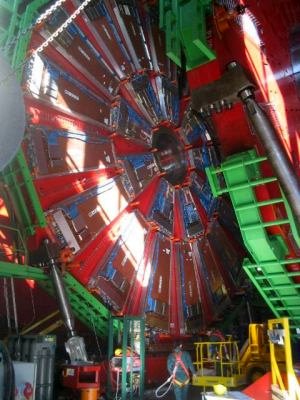|
Arthur Williams Wright
Arthur Williams Wright (September 8, 1836 – December 19, 1915) was an American physicist. Wright spent most of his scientific career at Yale University, where he received the first science Ph.D. awarded outside of Europe. His research, which ranged from electricity to astronomy, produced the first X-ray image and experimented with Röntgen rays. He also proved instrumental in securing funding for the first dedicated physics lab building in the United States, the Sloane Physical Laboratory. Biography Wright was born in Lebanon, Connecticut, to Jesse Wright and Harriet Williams. He attended Bacon Academy in Colchester, Connecticut, then graduated from Yale College in 1859. In 1861, he completed a dissertation on satellite mechanics at Yale under the direction of Hubert Newton and received a Ph.D., one of the first three awarded by an American university. (The remaining two were awarded to James Morris Whiton and Eugene Schuyler by Yale on the same occasion.) He spent two years as ... [...More Info...] [...Related Items...] OR: [Wikipedia] [Google] [Baidu] |
Lebanon, Connecticut
Lebanon is a town in New London County, Connecticut, United States. The population was 7,142 at the 2020 census. The town lies just to the northwest of Norwich, directly south of Willimantic, north of New London, and east of Hartford. The farming town is best known for its role in the American Revolution, where it was a major base of American operations, and for its historic town green, which is one of the largest in the nation and the only one still used partially for agriculture. History From Poquechaneed to Lebanon Lebanon was originally settled by the Mohegan people, an Algonquian-speaking tribe that inhabited the upper Thames River Valley in eastern Connecticut. The area was known as ''Poquechaneed'' and was used primarily for hunting.Alicia Wayland, Ed Tollman, Claire S. Krause, ''Images of America: Lebanon.'' (Charleston: Arcadia Publishing, 2004). p. 7 The town of Lebanon has its origins with the settlers of Norwich, who wanted to expand beyond the "nine miles square ... [...More Info...] [...Related Items...] OR: [Wikipedia] [Google] [Baidu] |
Bacon Academy
Bacon Academy is a public high school in Colchester, Connecticut, in the United States. In 1800 a prominent Colchester farmer, Pierpont Bacon, died and left an endowment of thirty-five thousand dollars (with buying power equivalent to that of about two million dollars in 2009). The endowment was to the :''inhabitants of the First Society of Colchester for the purpose of supporting and maintaining a school…for the instruction of Youth in Reading and writing English, in Arithmetic, Mathimaticks, and the Languages, or such other branches of Learning.'' This established the academy that bears his name. Bacon Academy's doors opened to the children of Colchester on the first of November 1803 and from that point forward, prepared many young men and women for the life that lay ahead. History In its early days, Bacon Academy had a reputation of preparing its students for accomplishment at universities and colleges around the country. Local children attended the school without charge ... [...More Info...] [...Related Items...] OR: [Wikipedia] [Google] [Baidu] |
Wilhelm Röntgen
Wilhelm Conrad Röntgen (; ; 27 March 184510 February 1923) was a German mechanical engineer and physicist, who, on 8 November 1895, produced and detected electromagnetic radiation in a wavelength range known as X-rays or Röntgen rays, an achievement that earned him the inaugural Nobel Prize in Physics in 1901.Novelize, Robert. ''Squire's Fundamentals of Radiology''. Harvard University Press. 5th edition. 1997. p. 1. In honour of Röntgen's accomplishments, in 2004 the International Union of Pure and Applied Chemistry (IUPAC) named element 111, roentgenium, a radioactive element with multiple unstable isotopes, after him. The unit of measurement roentgen was also named after him. Biographical history Education He was born to Friedrich Conrad Röntgen, a German merchant and cloth manufacturer, and Charlotte Constanze Frowein. At age three his family moved to the Netherlands where his family lived. Röntgen attended high school at Utrecht Technical School in Utrecht, Netherland ... [...More Info...] [...Related Items...] OR: [Wikipedia] [Google] [Baidu] |
Experimental Physics
Experimental physics is the category of disciplines and sub-disciplines in the field of physics that are concerned with the observation of physical phenomena and experiments. Methods vary from discipline to discipline, from simple experiments and observations, such as Galileo's experiments, to more complicated ones, such as the Large Hadron Collider. Overview Experimental physics encompasses all the disciplines of physics that are concerned with data acquisition, data-acquisition methods, and the detailed conceptualization (beyond simple thought experiments) and realization of laboratory experiments. It is often contrasted with theoretical physics, which is more concerned with predicting and explaining the physical behaviour of nature than the acquisition of empirical data. Although experimental and theoretical physics are concerned with different aspects of nature, they both share the same goal of understanding it and have a symbiotic relationship. The former provides data a ... [...More Info...] [...Related Items...] OR: [Wikipedia] [Google] [Baidu] |
Science Hill (Yale University)
Science Hill is a planning precinct of the Yale University campus primarily devoted to physical science, physical and biological sciences. It is located in the Prospect Hill (New Haven), Prospect Hill neighborhood of New Haven, Connecticut. Originally a 36-acre residential estate known as Sachem's Wood, it was purchased by the university in 1910 as a land bank. Removed from the main campus and close to the former Sheffield Scientific School, the hill was allocated to large science laboratories and the main buildings of the Yale School of Forestry & Environmental Studies. Several laboratory buildings were completed in the 1910s, but most of the campus was completed during the build-up of scientific research after World War II. Geography The topography of present-day Science Hill was primarily formed during the Wisconsinan glaciation. The Laurentide Ice Sheet flattened the soft sandstone of New Haven Harbor but had less effect on its surrounding, hard trap rock formations like ... [...More Info...] [...Related Items...] OR: [Wikipedia] [Google] [Baidu] |



